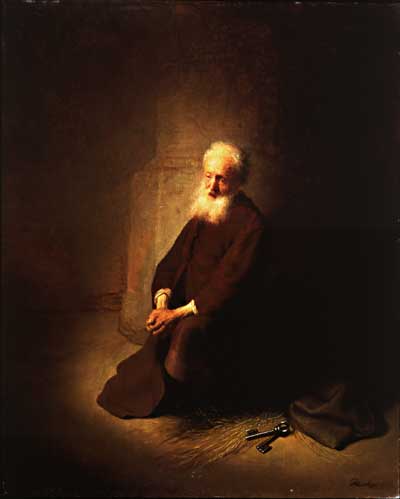1 and 2 Peter and Jude

The author of 1 Peter is Peter, the disciple of Jesus (1 Pet 1:1). He indicates that he was an eyewitness to Christ's suffering (1 Pet 5:1). The letter is written to a collection of churches in Asia Minor (1 Pet 1:1). Peter is writing from Rome, however, he feels the need to adopt the code word "Babylon" (1 Pet 5:13) for Rome. This code was used also in Revelation and in later early Christian writings, and will be an important factor in dating the book. Mark is with Peter in Rome (1 Pet 5:13).
1 Peter is written with a background of imminent persecution (1 Pet 1:6, 2:12, 2:19-21, 3:13-17, 4:12-19, 5:8-10). There are two things noteworthy about these warnings of persecution. First, unlike many earlier warnings of persecution against early Christians, this time there is no indication that the Jews are involved. Second, Peter repeatedly warns his readers to be good citizens (2:13), and the warnings of persecution sound as though the Christians are in a precarious position with the governing authorities, so they need to be on their best behavior. Even good behavior will not eliminate the "fiery trial" that is coming (1 Pet 4:12), but it may ease the consequences.
Therefore, the background of 1 Peter has three conditions:
- Mark is in Rome with Peter
- There is a background of persecution, and it is coming from Roman authorities rather than the Jews
- Peter feels a need to conceal the fact that he is in Rome.
Having dated 1 Peter at 65 A.D., which is not long before Peter's death, the question arises whether 2 Peter actually must follow 1 Peter in time. 2 Pet 3:1 says "This second epistle, beloved, I now write unto you", and this verse is the reason 2 Peter is considered "second." However, this argument only applies if the recipients of 1 Peter and 2 Peter are the same people, and the evidence seems to indicate that they are not. While 1 Peter is written to mostly gentile churches in Asia Minor (1 Pet 1:1) in danger of persecution, 2 Peter has no such physical address, and seems more to target Jewish Christians in danger of false teachers.
In 2 Peter perhaps more than any other New Testament book, the identity of the named author has been challenged, and many scholars do not believe the apostle Peter is the author of the book. However, the author clearly is claiming to be Peter, as he identifies himself as an eyewitness to the transfiguration (2 Pet 1: 16-18). Scholars point to differences in Greek writing style between 1 Peter and 2 Peter, but this may be due to Peter using different scribes to actually do the writing for each book.
2 Peter and Jude should be discussed together, since there is a sharp similarity between the two, especially in the second chapter of 2 Peter. Both books warn of false teachers and have the unusual discussion of, among other items:- angels that sinned (Jude 6, 2 Pet 2:4)
- Sodom and Gomorrha (Jude 7, 2 Pet 2:6)
- Balaam (Jude 11, 2 Pet 2:15)
A key to the connection between Jude and 2 Peter has been suggested by Robinson, [Robinson, John A.T., Redating the New Testament, pp193ff]. Jude 3 says he was intent on writing a letter dealing with the "common salvation", but events intervened to change the focus of the letter to warn of false teachers and encourage the recipients to contend for the faith. Peter probably wrote both his letters with the help of a scribe - for 1 Peter it was apparently Sylvanus (1 Pet 5:12). With 2 Peter the scribe may have been Jude. This type of connection between Peter and Jude would explain the sharp similarities between the two books. It would also mean that 2 Peter and Jude should be dated to essentially the same time.
When would this time be? 2 Peter 3:16 carries a reference to Paul's letters, thereby negating the possibility of a very early date for the book. Likewise, Jude 17 looks back on "the words which were spoken before of the apostles of our Lord Jesus Christ", so no very early date is possible. On the other hand, Jude presents himself as "the brother of James", James being the half brother of Jesus and head of the Jerusalem church. Since James was executed in 62 A.D., and no hint of such an event is in either Jude or 2 Peter, both books should be placed before that date. It was also around 62 that Peter went to Rome. For Jude to be Peter's scribe, both would probably need to still be in Jerusalem. The most likely date window for 2 Peter and Jude therefore narrows to around 60 A.D.